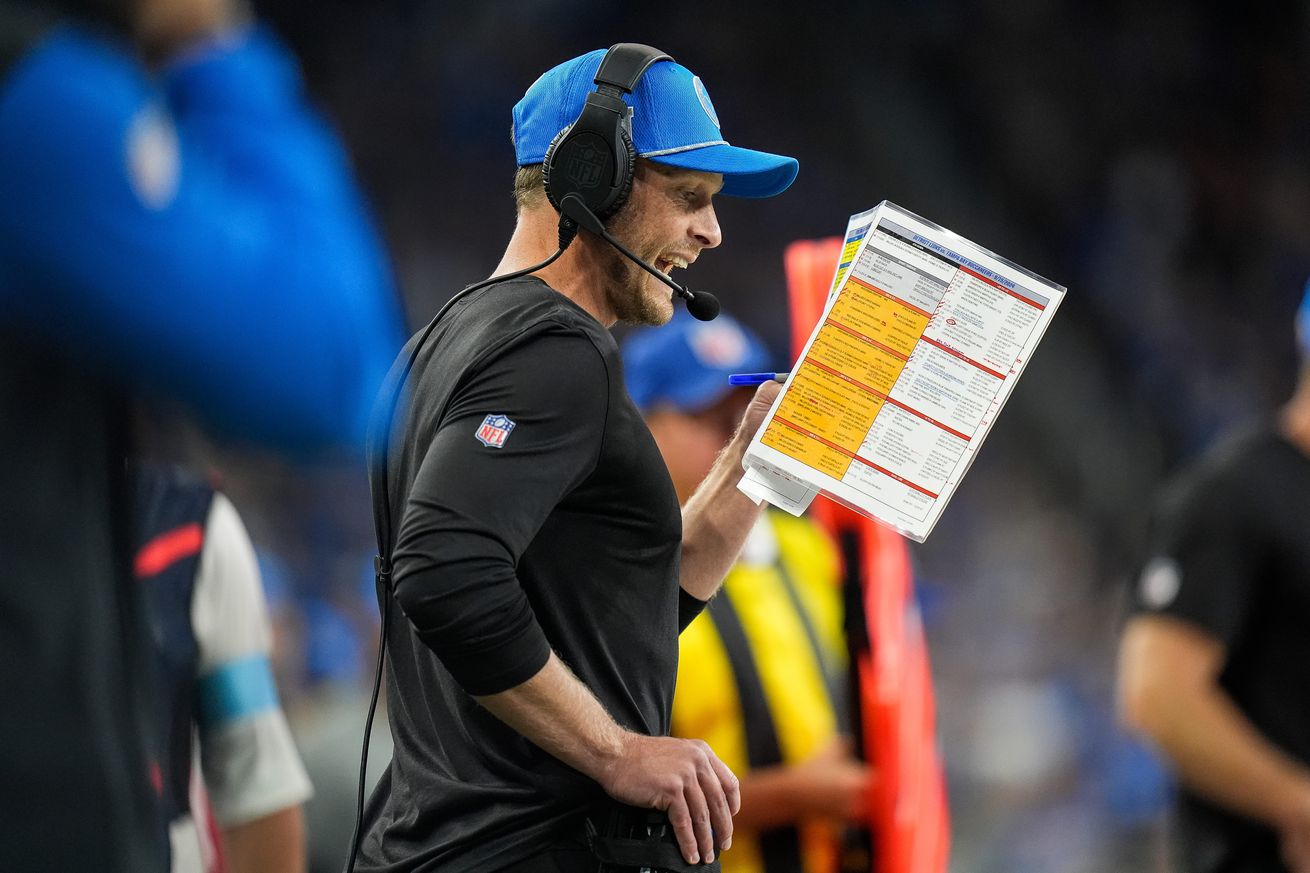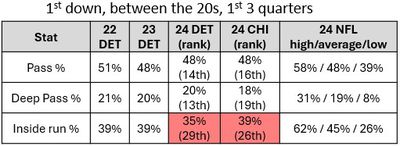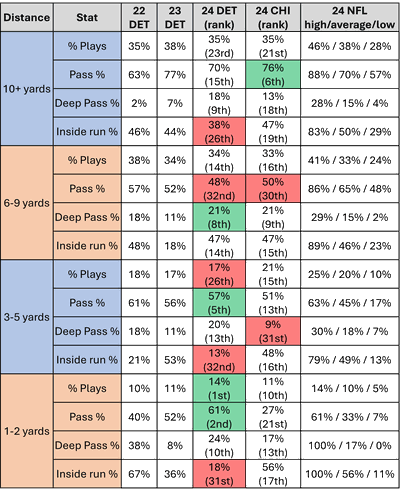
For the second consecutive offseason, the Chicago Bears have brought in a new offensive coaching staff, and new head coach and offensive playcaller Ben Johnson will be tasked with turning Chicago’s talent into a cohesive and effective unit. Since Johnson spent three years as the play caller in Detroit, today I want to dig into his data to see what we can learn that might translate to Chicago. I am going to focus mostly on what his play calling tendencies were and less on how effective the offense was, because effectiveness will depend significantly on personnel, which will be entirely different in Chicago.
I’ll start today by exploring what Johnson likes to do in various down and distance situations.
1st Down
We’ll begin by looking at 1st down. The table below shows how often Detroit called a passing play vs. a running play, how many of their passes went deep down the field (15+ yards past the line of scrimmage in the air), and how many of their runs were inside the tackles. A few quick notes:
- To remove game situation as much as possible, I only looked at plays between the 20s in the first three quarters. This is a look at what Johnson liked to do in fairly neutral situations. These same criteria will apply to all data in this article.
- I looked at Detroit for 2022, 2023, and 2024 so we could see what trends were consistent from year to year and what ones changed. This might give hints as to what Johnson will likely keep vs. what might shift depending on personnel.
- I also showed what Chicago looked like in 2024, so we can get a general idea of how things might change compared to what we saw last year.
- To put all these numbers in context, I provided the high, average, and low values for all 32 NFL teams in 2024, and where the 2024 Bears and Lions ranked in each category. Values in the top 25% are highlighted in green, while those in the bottom 25% are highlighted in red.
- All data comes from Pro Football Reference’s game play finder.

A few thoughts:
- Most of the data here matches NFL averages fairly closely. On 1st down, Johnson’s offenses consistently ran about as frequently as the typical NFL team, and took deep shots at a fairly typical rate when they did throw. Those trends were all fairly consistent as personnel changed across three seasons, suggesting they will likely stay the same in Chicago.
- The one thing that stands out here is that Johnson prefers outside runs on 1st down, as the Lions were consistently one of the most outside-heavy running teams during all three seasons he called plays.
* I dug a little deeper here and found an interesting nugget: Johnson changed the inside/outside run splits quite a bit based on the specific running back. In neutral situations (1st/2nd down, between the 20s, first 3 quarters), Jahmyr Gibbs saw only 32% of his runs inside the tackles between 2023-24, while David Montgomery – who is a better inside runner – saw 42% of his runs in those situations come between the tackles.
* Like Gibbs, D’Andre Swift is a much better runner outside the tackles than in, but he still saw 45% of his neutral runs come inside the tackles last year. He averaged a paltry 3.5 yards/attempt on those inside runs, frequently putting the offense behind the chains. This was a potential problem I pointed out before the 2024 season, and I was disappointed to see the Bears not play to Swift’s strengths as a runner in 2024. Swift very likely won’t be asked to do as much of what he’s bad at as he did last year, which should help him be more effective in 2025.
2nd down
Let’s shift now to 2nd down, where distance starts to become important. While virtually all 1st down plays are 1st and 10, there is a wide range of possibilities on 2nd down, and play callers are going to approach 2nd and 10 significantly differently than 2nd and 2. With that in mind, I took the same data as 1st down above for 2nd down plays, but also split it into different groupings based on yards needed to gain a 1st down. Once again, ranks in the top 25% are highlighted in green, while those in the bottom 25% are in red, and data is only for plays in the first 3 quarters between the 20s.

A few thoughts:
- Here we start to see some interesting patterns that are quite different from NFL averages. It seems Johnson likes to zig when the NFL zags.
* Johnson’s Detroit offenses consistently ran it more often than typical on 2nd and longer distances (6-9 yards), when the defense is likely expecting a pass. On the flip side, Johnson liked to call passes on 2nd and short-medium (1-2 and 3-5 yards) quite a bit more than normal, trying to catch the defense off guard when they expect a run.
* Johnson also liked to take deep shots when passing on 2nd and short more than expected; his offenses averaged a deep shot on about 24% of passes in these situations from 2022-24, well above the NFL average of 17%. This is presumably because Johnson was confident he could pick up a 1st down on 3rd or 4th and short, and thus wanted to try and grab a big play when the opportunity presented itself.
- It’s also worth noting the outside-heavy run approach remained pretty consistent across all three years. That’s something I fully expect Johnson to bring with him to Chicago.
3rd and 4th Down
Finally, let’s look at 3rd and 4th down, where goals shift pretty exclusively to gaining a 1st down to keep a drive alive. Like we did above with 2nd down, let’s split this up by distance to see what that shows.

A few thoughts:
- Most NFL teams pass the ball on 3rd/4th down unless it is a short-yardage situation (1-2 yards to go), when they usually run it. The passing trend is even stronger than it appears in this data since QB scrambles were called passing plays that end up as runs here.
* Ben Johnson likes to push back against those trends a bit. His passing rates are especially low in the longer-mid range (6-9 yards to go), which is especially notable given that Jared Goff rarely scrambles, so most runs here were called. Johnson is a heavy proponent of analytics, which often supports going for it on 4th down, and I would guess that in these situations, he is looking to set up a 4th and short with the idea of going for it.
* Bobby Peters, a great Xs and Os guy who you should definitely follow, has described Johnson’s 3rd down mid-range run game as, and I quote, “sweet.” You can view a breakdown of a few such plays here, or buy his books for the 2022 and 2023 Lions to get a deeper glimpse into Johnson’s offense.
* Johnson also likes to throw a bit more than often on 3rd/4th and short (1-2 yards to go), though that trend dried up in 2024. I’ll be curious to see what that looks like for Chicago in short-yardage situations this year.
- Like most teams, Johnson trends towards more inside runs in 3rd/4th and short, since those need to hold up for less time to get the minimal yardage needed to convert. However, that trend notably changed in 2024, and this is due to personnel. David Montgomery, the typical short-yardage back, got hurt, and Jahmyr Gibbs took more of those carries. Across 2023-24, 56% of Montgomery’s 3rd/4th and short carries were inside the tackles, compared to only 38% for Gibbs.
Lessons Learned
Ben Johnson said in his opening press conference that he would build his offense around the personnel he had, rather than simply bringing exactly what he did in Detroit to Chicago. We can see some evidence of him doing that in Detroit, including significantly changing where he calls runs based on the skill set of the running back in the game.
Still, we can see some trends from Johnson’s three years with the Lions that have remained consistent even as the personnel changed, which makes it reasonable to believe those will follow him across Lake Michigan to the Bears. Most notably, Johnson consistently prefers to run outside the tackles at a heavy rate, but we also saw that Johnson likes to call runs when defenses expect a pass (2nd and long, 3rd/4th and medium).
Stay tuned for part 2 of this series, where we’ll explore how Johnson utilized different personnel groupings in his time in Detroit.